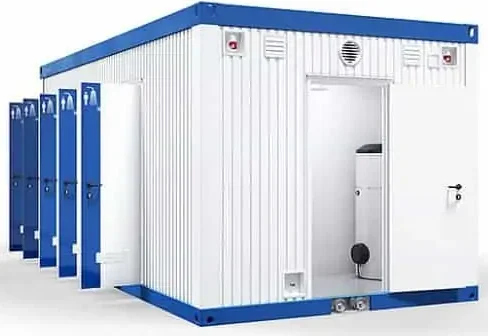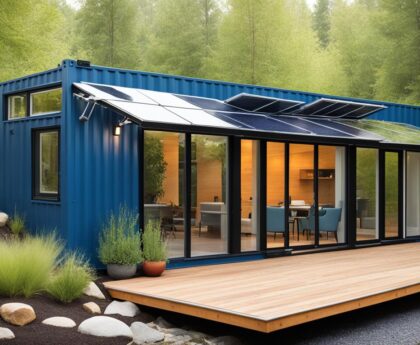Finding the right shipping container can change the game. It’s great for expanding storage, starting a DIY project, or solving shipping needs. This guide will cover the many uses of shipping containers, sizes, and what to think about when buying. By the end, you’ll know how to pick the best shipping container for your needs.
Key Takeaways
- Discover the wide range of applications for shipping containers, from storage to living spaces.
- Understand the importance of considering container size, condition, and customization options when making a purchase.
- Learn where to find reputable sellers and marketplaces to buy shipping containers.
- Explore the cost factors and pricing considerations when purchasing a shipping container.
- Prepare for the delivery and installation process, including site preparation and permitting requirements.
Discover the Versatility of Shipping Containers
Shipping containers are more than just for moving goods. They are strong, modular units that can be used in many ways. You can turn them into unique homes, workshops, or offices. The uses for shipping containers are endless.
Explore the Many Uses for Shipping Containers
These containers can be changed into many useful and creative things. Some popular ways to use them include:
- Storage units for homes, businesses, or construction sites
- Mobile offices or workspaces
- Portable workshops for DIY fans or small businesses
- Eco-friendly and sustainable housing options
- Disaster relief shelters or temporary homes
- Retail spaces, pop-up shops, or food trucks
From Storage to Living Spaces: The Possibilities Are Endless
Shipping containers can be changed and customized for many needs. They can be stacked, linked, or changed to make unique spaces. From small home offices to big houses, the possibilities are endless. The creativity and ingenuity of those who repurpose shipping containers are the only limits.
| Uses for Shipping Containers | Examples |
|---|---|
| Storage | Household items, business inventory, construction materials |
| Workspace | Mobile offices, workshops, retail spaces |
| Living Spaces | Affordable housing, vacation homes, disaster relief shelters |
Shipping containers offer endless chances for creative and useful projects. If you need more storage, a special workspace, or a custom home, these containers can help. They are strong and versatile.
“Shipping containers are the ultimate blank canvas for innovation and creativity. The only limit is your imagination.”
Understanding Shipping Container Sizes and Specifications
When looking at shipping containers, size and specs matter a lot. Containers come in various standard sizes, each with its own set of features and dimensions. It’s key to know these sizes to pick the right one for your needs.
The most common sizes are:
- 20-foot containers – These are 20 feet long, 8 feet wide, and 8.5 feet tall. They can hold about 1,170 cubic feet.
- 40-foot containers – These are a bit bigger, measuring 40 feet long, 8 feet wide, and 8.5 feet tall. They have a capacity of around 2,390 cubic feet.
- High cube containers – These are similar to the 40-foot containers but are taller, at 9.5 feet. They offer about 2,660 cubic feet of space.
There are also special sizes like 45-foot and 53-foot containers for certain needs.
| Container Size | Length | Width | Height | Capacity (cubic feet) |
|---|---|---|---|---|
| 20-foot | 20 feet | 8 feet | 8.5 feet | 1,170 |
| 40-foot | 40 feet | 8 feet | 8.5 feet | 2,390 |
| High Cube | 40 feet | 8 feet | 9.5 feet | 2,660 |
Knowing the shipping container dimensions, shipping container sizes, and shipping container specifications is key. Whether for storage, transport, or building a unique space, understanding these details helps you choose wisely.
“Choosing the right shipping container size is essential for maximizing efficiency and cost-effectiveness in your transportation or storage needs.”
Factors to Consider When Buying a Shipping Container for Sale
When you’re looking to buy a shipping container, there are key factors to think about. You need to consider the condition and customization options. This will help you find the right shipping solution, whether it’s a used shipping container or a customized shipping container.
Condition: New vs. Used Containers
Choosing between a new shipping container and a used shipping container is a big decision. Here are the pros and cons of each:
- New containers are in top shape and come with a warranty but are pricier.
- Used containers save money but might show wear and tear, and their condition can vary.
When looking at used containers, make sure to check for dents, rust, and any repairs or changes needed.
Customization Options and Modifications
Shipping containers can be changed to fit many uses, from storage to homes. Some common changes include:
- Adding windows, doors, and vents
- Insulating for better temperature control
- Installing electrical and plumbing
- Custom painting and branding
If you need specific changes, consider working with a trusted supplier or a company that specializes in modifying containers. This ensures your customized shipping container meets your needs.
“Customizing a shipping container can turn it into a versatile and functional space, tailored to your unique needs.”
| Feature | New Containers | Used Containers |
|---|---|---|
| Condition | Pristine | Varied, may require repairs |
| Price | Higher | Lower |
| Warranty | Yes | Depends on seller |
| Customization | Possible | Possible |
Where to Find Reliable Shipping Container Sellers
Finding a good seller for a shipping container is key. Luckily, there are many places to look, from online to local directories. We’ll show you how to find the best places to buy your shipping container.
Online Marketplaces and Directories
The internet makes it easy to find shipping container sellers and shipping container retailers. Online marketplaces and directories are a great start. They have a wide range of new and used containers. This lets you compare prices and features to find what you need. Some top online choices include:
- Online classifieds and auction sites like eBay and Craigslist
- Specialized where to buy shipping containers directories and listings
- Manufacturer and supplier websites
When looking online, check the seller’s reputation, reviews, and shipping policies. This ensures a smooth and easy buy.
Don’t forget to look at local shipping container sellers and retailers too. They often offer personal service and support during the buying process.
| Retailer | Container Sizes | Pricing | Delivery Options |
|---|---|---|---|
| Container King | 20ft, 40ft | $2,500 – $5,000 | Nationwide delivery |
| Acme Containers | 10ft, 20ft, 40ft | $1,800 – $4,200 | Local pickup only |
| Global Container Solutions | 20ft, 40ft, 45ft | $3,000 – $6,500 | Nationwide and international delivery |
By checking these options, you’ll find the perfect shipping container for your needs at a great price.
Shipping Container for Sale: Cost and Pricing Factors
Buying a shipping container can be a big expense. The price varies a lot, depending on several things. We’ll look at the typical costs for new and used containers. We’ll also see what affects the price.
New vs. Used Shipping Containers
New shipping containers are pricier, costing between $3,000 to $6,000 for a standard 20-foot one. Used ones are cheaper, costing $1,500 to $3,500, based on their condition and age. The size, material, and any special features also change the price.
Factors Affecting Shipping Container Prices
Several things can change the price of a shipping container:
- Container size (20-foot, 40-foot, etc.)
- Condition (new, used, or refurbished)
- Location and availability
- Customization or modifications
- Transportation and delivery costs
Think about these factors when planning to buy a shipping container. This way, you can get a good deal.
| Container Size | New Shipping Container Prices | Used Shipping Container Prices |
|---|---|---|
| 20-foot | $3,000 – $6,000 | $1,500 – $3,500 |
| 40-foot | $4,500 – $8,000 | $2,500 – $5,000 |
“The cost of a shipping container is an important consideration, but it’s just one factor to weigh when making a purchase. Evaluating the condition, size, and customization options can help you find the right container at the best price.”
Preparing for Delivery and Installation
After you’ve sold your shipping container, get ready for its delivery and setup. This means making your site ready and getting the right permits. Planning ahead makes the setup smooth and easy.
Site Preparation for Shipping Containers
Before the container arrives, prepare the spot where it will go. This means cleaning the area, making the ground level, and checking access for the truck. You might also need to strengthen the ground or put down a concrete pad, depending on the container’s weight and your property’s needs.
- Check the area and remove any obstacles or debris
- Level the ground or prepare a solid base
- Make sure there’s enough space and access for the truck
- Think about any extra work, like setting up utilities or adding a ramp
Permitting Requirements for Shipping Container Installation
Installing a shipping container might need permits or approvals in your area. This is crucial if you’re using it for a home or business, as there could be rules about where and how you can place it. Make sure to look into what you need and send in your paperwork early, before the container comes.
| Permit Requirement | Typical Considerations |
|---|---|
| Zoning Approval | Checking that the container fits local zoning laws |
| Building Permits | Getting permits for any changes or structures added to the container |
| Utility Connections | Working with utility companies for power, water, or sewage connections |
Getting your site ready and getting the right permits makes the shipping container delivery and installation go smoothly. This sets you up for a successful project.

Maintaining and Securing Your Shipping Container
Keeping your shipping container in good shape is key to protecting your stuff. It’s a great way to store and move things. Taking care of it helps it last longer and keeps your stuff safe.
Tips for Proper Maintenance
Here are some steps to keep your shipping container looking new:
- Regular Cleaning: Clean the inside and outside with a mild detergent and water to stop dirt and rust from building up.
- Rust Prevention: Look for any rust and fix it quickly with rust-inhibiting paint or sealant to stop it from getting worse.
- Ventilation: Make sure there’s airflow by keeping the doors and vents open. This stops moisture and mold from building up.
- Inspections: Check the container often for any damage, leaks, or other problems that need fixing.
Enhancing Security
It’s important to keep your shipping container and what’s inside safe. Here are some ways to do that:
- Install High-Quality Locks: Use strong, hard-to-open locks to keep the doors closed to others.
- Consider Surveillance Measures: Put in security cameras or motion sensors to watch the area and scare off thieves.
- Secure the Container’s Placement: Put the container where it’s well-lit and easy to see to stop theft and damage.
- Maintain Proper Documentation: Keep records of what’s inside, its condition, and any changes. This helps if there’s a security problem.
By following these tips, you can make sure your shipping container stays in great shape and keeps your stuff safe.
| Maintenance Task | Frequency | Benefits |
|---|---|---|
| Cleaning | Quarterly | Prevents buildup of dirt and rust |
| Rust Inspection | Biannually | Identifies and addresses rust issues early |
| Structural Inspection | Annually | Ensures the container’s integrity and safety |
| Lock Maintenance | As Needed | Maintains the security of the container |
Shipping Containers: An Eco-Friendly and Sustainable Choice
Shipping containers are now a top choice for logistics and building projects. They are not just useful; they are also good for the planet. These containers can be reused, offering big environmental benefits.
The eco-friendly aspect of shipping containers comes from their durability. They can handle tough transport conditions. After their first use, they can be given a new life, cutting down on new materials and waste.
Also, building with shipping containers is efficient and saves energy. It’s different from traditional building, which uses a lot of resources and creates waste. Containers can quickly turn into different structures, like storage or homes, with less harm to the environment.
Using shipping containers also helps the environment in other ways. They’re great for off-grid projects like eco-friendly homes and mobile clinics. These projects use the containers’ strength and design to lessen their impact on the planet.
“Shipping containers are the perfect example of how we can transform waste into valuable resources and create a more sustainable future.”
As we look for eco-friendly solutions, shipping containers stand out. They offer many benefits for various industries and uses. By using these containers, we can help make the world greener and more sustainable.

Conclusion
Finding the right shipping container is key to using their many benefits. These containers are great for storage, living spaces, and more. They are both practical and good for the planet for people and businesses.
Knowing what to look for, like size, condition, and custom options, helps you pick the best one. This guide gives you the tools to make a smart choice. Whether you need storage or a unique place to live, you’re set.
In short, shipping containers are versatile and sustainable. They offer many possibilities, from storage to living spaces. By choosing shipping containers, you open up new chances to meet your needs.



